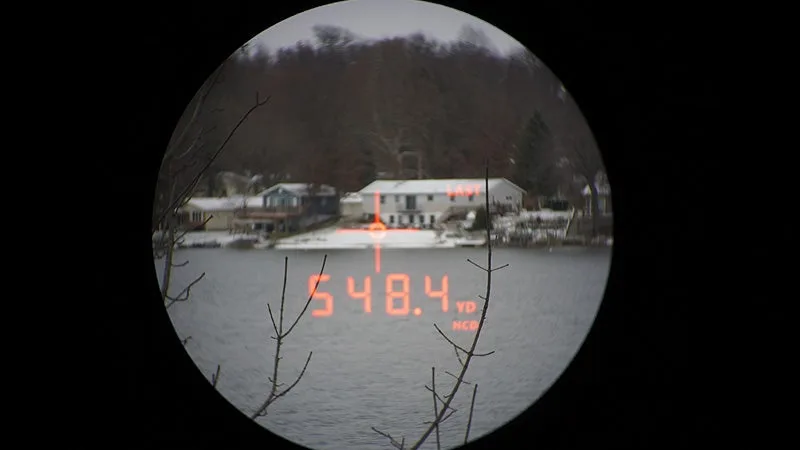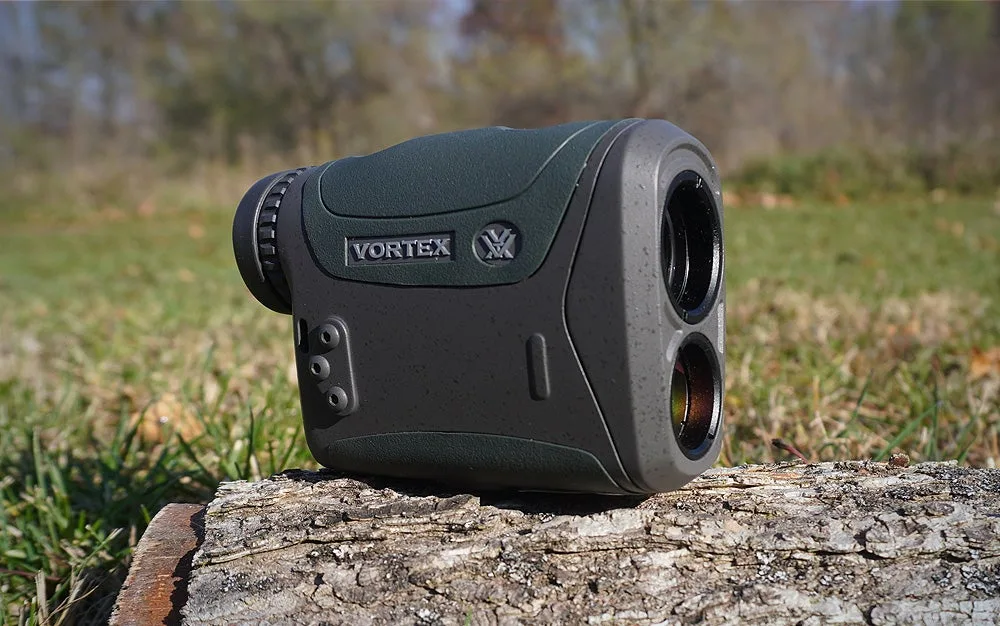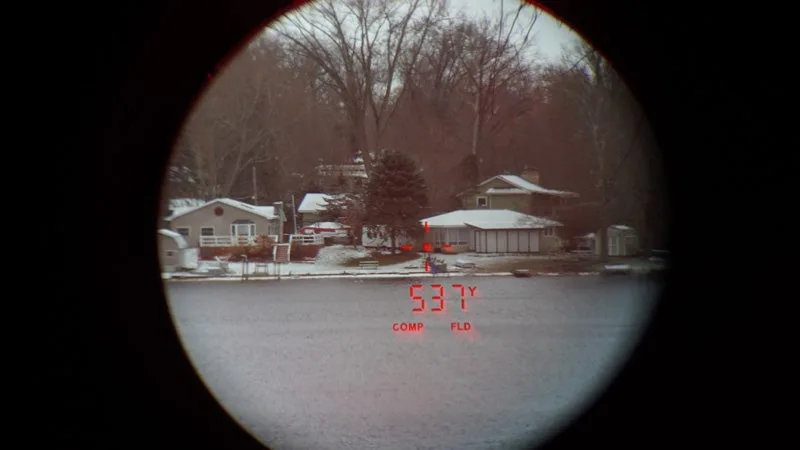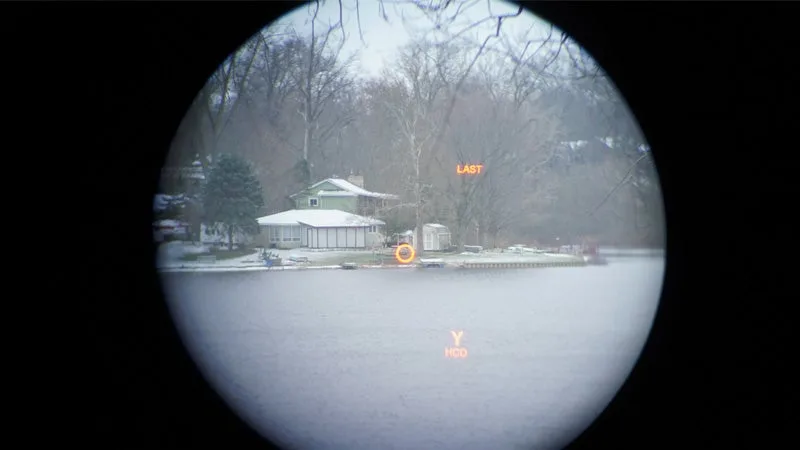Best Overall

Maven RF.1 7×25
LEARN MORE
Summary
The Maven has exceptional clarity, the fastest controls, and is easy to use in a variety of hunting scenarios.
Best Budget

Redfield Accuranger
LEARN MORE
Summary
The Accuranger features a great display and functionality for a rangefinder that has an ultra-low $150 price tag.
Best For Bowhunting

Ravin 1200
LEARN MORE
Summary
The Ravin is fast and simple, perfect for close range bowhunting scenarios in differing light conditions.
A good rangefinder solves a conundrum that every hunter has found themselves in at some point. Just how far away is that big buck or bull? Misjudge the distance and you could end up missing, or worse, simply wounding the animal. No hunter wants that. Sure, you can step off the distance and make mental notes using objects in your shooting lanes. But when you’re out in the field in an unpredictable situation, a laser rangefinder is a better idea.
Today’s rangefinders are better than ever in delivering the exact distance to a target with pinpoint accuracy. With one in your arsenal of hunting gear, there’s no more guesswork or blaming inaccurate distance for not making a shot. It makes them highly valuable tools for hunters no matter if you prefer to use a bow or firearm. With that in mind, we tested some of the best rangefinders currently available—and these are the results.
Best Overall: Maven RF.1 Rangefinder 7×25
Best Budget: Redfield Accuranger 1300
Best Value: Vortex Crossfire HD 1400
Best For Bowhunting: Ravin 1200
Best For Long Range Shooting: Vortex Razor HD 4000
How We Picked the Best Rangefinders
We tested all the rangefinders on this list over a period of three months. I first took all the rangefinders to a high school football field and ranged from the goal line to the goal post on the opposite end of the field, which is 110 yards. Accounting for the goal post’s placement back behind the back goal line, the rangefinders all put that distance at 112 or 113 yards. There was only about a 1-yard difference between the models tested, confirming they were all accurate.
I then used each rangefinder on multiple whitetail deer hunts in both Michigan and Wisconsin. I also tested them on a variety of other targets at ranges from 15 all the way up to 1,850 yards in different light conditions. Most importantly, I tested the clarity of each at those all-important low light moments.
While testing, I noted things like button placement and ease of operation. I thought about which rangefinder I’d want in my hand when that big buck is charging into my setup and I might only have a few seconds to get a reading. I judged the clarity of the view through each finder, and how easy it was to read the display numbers. I also considered the following factors when making my decision:
Weight: Is the rangefinder especially bulky? Is it bothersome sitting in a rangefinder pouch?
Compensation: Does the rangefinder have angle compensation for treestands or long-distance shooting?
Value: Does the quality of the rangefinder match the price point? Does it have additional features or a pouch included standard?
Controls: How easy is it to change the settings?
Best Rangefinders: Reviews and Recommendations
Best Overall: Maven RF.1 Rangefinder 7×25
Best Overall

Specs
Maximum Range: 4,500 yards (reflective)
Magnification: 7x
Dimensions: 4.6875” x 3”
Pros
Amazing clarity
Fast and easy controls
Fast readings
Cons
Large profile
The Maven RF.1 stands out from the pack because of how intuitive it is to use, thanks to the controls level and knob. While most rangefinders use a complicated two-button system to adjust brightness or shift between ranging modes, the RF.1 uses a lever and a knob. I loved how I could shift between field and forest ranging modes in an instant without even thinking. This is huge deal for me because I vary between hunting food plots and dense forests filled with thick undergrowth. I was pleased with how the forest mode cuts through all the small limbs to give me a reading on deer that won’t break cover.

The control knob and lever make the RF.1 the easiest to operate rangefinder of the test. Travis Smola
The control knob helps select things on the internal menus, but I love the fact the default setting of the knob is for the reticle brightness. It allowed me to turn it up or down for the light conditions instantly without fumbling my way through a ton of menu options first. When a big buck may only make a fleeting appearance, this kind of feature matters.
I was impressed with the clarity, especially when I tried it at last light. It also has reach for long range, too. I easily ranged a distant barn on my Wisconsin deer hunt at 1,850 yards. But I also ranged non-reflective targets at 1,300 yards quite efficiently, along with some does in the darkness of first light at 250 yards.

The clarity through the RF.1 is exceptional and a standout with all the rangefinders I tested. Travis Smola
The only real downside to this rangefinder is that the control knob gives it a slightly wider profile. It doesn’t slip into a pocket or pouch on a binocular harness
quite as seamlessly as other rangefinders. In fact, it didn’t fit the pouch on my Vortex binocular harness at all. This takes a little while to get used to it, but the clarity and ease of use is a worthwhile trade off in my mind.
Best Budget: Redfield Accuranger 1300
Best Budget

Specs
Maximum Range: 1,300 yards
Magnification: 6x
Dimensions: 4.48” x 1.38”
Pros
Bright easy-to-read display
Lightweight
Bonus case
Cons
Exterior is a little slick
Clarity is less in low light
I’ve been consistently impressed with the quality of Redfield’s gear. This is an Academy Sports house brand that’s clearly targeted towards hunters on a budget. But none of this equipment feels cheap, and that includes the Accuranger 1300. It’s very comparable to more expensive brands in terms of size, weight, and feel.
I first used this rangefinder during a press trip to Texas while tagging metal targets at 450 yards with a 6.5 Creedmoor. It was also dead-on for 100, 200, and 300 yards. I was even able to range targets at 1,100 yards. I couldn’t get this one to range that barn in Wisconsin at 1,800 yards that I mentioned earlier. But that works fine for me since I rarely range beyond 100 anyway.

The Redfield has one of the largest number displays of the models that I tested. Travis Smola
Another small quip is that the clarity wasn’t the best when ranging in low light conditions. But I really like the display for this finder. It’s super bright and easy to read. It also features the largest numbers of all the models I tested. For anyone who feels their eyes aren’t what they once were, it’s a good option. Considering the $149 price point, this finder is a true bargain for the average hunter on a budget.
Best Value: Vortex Crossfire HD 1400
Best Value

Specs
Maximum Range: 1,400 yards
Magnification: 5x
Dimensions: 4” x 1.3”
Pros
Slim profile
Lightweight
Large display
Cons
Difficult menu system
The Crossfire was the most affordable of the Vortex rangefinders that I tested, and the value here is great. The slim profile fits perfectly in a rangefinder pouch and it feels great in the hand. I ranged targets up to around 1,250 yards with it and the accuracy was spot on.
My favorite part of this one is the reticle. It makes it easy to be precise on targets at a distance. Plus, the brightness levels are adjustable. It was set at a very low level when I first powered it up, but just requires a two-second hold of the menu button to bring it up.

The Crossfire features a larger reticle than some of the other Vortex options I tested. Travis Smola Travis Smola
That little quirk aside, the clarity of this rangefinder is good, especially for a mid-tier price of $200. The numbers on the display are also slightly larger than some of Vortex’s other models. It’ll be an easier read for anyone with eyesight issues.
Best For Bowhunting: Ravin 1200
Best For Bowhunting

Specs
Maximum Range: 1,200 yards
Magnification: N/A
Dimensions: 4.5” x 1.5”
Pros
Lightweight
Great buttons
Auto-changing reticle colors
Cons
A bit bare in features
The Ravin laser rangefinder is rather simple and to the point. That’s not a bad thing. Not everyone needs a bevy of ballistic data, especially bowhunters. I found the 1200 to be incredibly fast and accurate in yardage and angle readings. In fact, it was one of the faster rangefinders of the test. I was able to range a small, reflective shed at 1,274 yards with it. Although that’s over the maximum advertised range, I also couldn’t range anything beyond that. But to be fair, I don’t think many long distance shooters will consider this one because of the aforementioned lack of ballistics data anyway. The design of this rangefinder truly is meant for those carrying a compound or crossbow into the woods and it serves that purpose quite admirably.

The Ravin’s display is simple, crisp, and fast. Travis Smola
I also need to note that the battery that came with this rangefinder was dead on arrival. A quick look online shows I’m not the only one who had this problem. But I’m not going to hold that against them because it’s an easy fix to buy a new one. Hopefully Ravin finds a better source of batteries.
One thing that isn’t noted on the Ravin website is the reticle. It automatically shifts color from black to red based once it starts detecting a loss of ambient light. I dig this because bowhunting is hard enough without worrying about seeing the reticle on that shooter at last light. This rangefinder is the definition of point and click, and for most average hunters, that’s all you need.
Best For Long Range Shooting: Vortex Razor HD 4000
Best For Long Range Shooting

Specs
Maximum Range: 3,000 yards
Magnification: 7x
Dimensions: 4.2” x 1.7”
Pros
Extreme long range capabilities
Feels great in the hand
Excellent clarity
Cons
Price
I was easily able to range non-reflective targets out past 1,600 yards free hand with the Vortex Razor. Combine that effectiveness with the advanced features of ballistic data in the GB variant, and this is the ideal choice for long range distance readings. At 10.1 ounces, I found this rangefinder a little on the heavy side, but it has a nice feel in the hand. It was extremely easy to operate under any light conditions. The menus are a little easier and faster to use than some of the other Vortex models I tested too. This rangefinder also had the best clarity of all the Vortex options. I found it excellent in low light conditions.

The Razor was my favorite display of all the Vortex models I tested. Travis Smola
The main downside of this rangefinder is the price. The standard version is $500, while the ballistic version—which also gathers data on crosswinds, ambient temperature, and pressure—is a whopping $800 for those extra features. This rangefinder obviously isn’t for everyone. But for those who are dialing in extreme shots extreme ranges over 1,000 yards, it’s going to deliver all the data you’ll ever need.
**Vortex Viper HD 3000
**

Specs
Maximum Range: 3,000 yards (reflective) 2,000 yards (deer)
Magnification: 7x
Dimensions: 4.2” x 1.7”
Pros
Great feel
Fast
Easy menus
Cons
Expensive
The Vortex Viper has a great weight and texture that just felt right in my hand every time I picked it up. Vortex did an excellent job on the construction as this was the most rugged feeling of the finders that I tested. I was easily able to range objects nearly 1,700 yards away with it while holding it freehand. The buttons feel great and were easy to operate without needing to look at them. The menus are also extremely easy to navigate.

The Viper’s clarity was excellent during testing under a variety of lighting conditions. Travis Smola
When I tested this rangefinder in hardwoods it had little trouble cutting through the dense undergrowth to range the targets I wanted. The scan mode is excellent, although it excels best in wide open areas. The only thing I don’t like about it is the price. This finder is packed full of great features, but at $400, I feel like it’s a little outside the budgets of most average hunters.
Maven CRF.1 6×22

Specs
Maximum Range: 2,400 yards
Magnification: 6x
Dimensions: 4.33” x 2.95”
Pros
Excellent clarity
Fast readings
Two reticle colors
Cons
Price tag
The Maven CRF.1 has a slimmer profile than the RF.1 but is just as fast and effective for a variety of hunting scenarios. I was able to range targets out to 1,100 yards with the CRF.1 rather easily. The reticle is the most notable difference here because this reticle can be changed from black to red rather seamlessly. I found the red worked best for low light conditions while the black worked best in bright sunlight. Unlike the RF.1, this rangefinder features a light sensor that automatically adjusts the reticle brightness based on ambient light. I never had a problem viewing it. But I also think there’s likely to be hunters who prefer brightness settings that can be manually adjusted.

It was difficult to photograph, but the CRF.1’s reticle automatically adjusts in brightness depending on the conditions. Travis Smola
One huge upside to this and the RF.1 that I didn’t mention before is that Maven offers an unconditional lifetime warranty on their optics. That’s a nice bit of peace of mind when investing in an optic this expensive. Finally, I just loved the clarity of this optic. I had zero issues finding and following a moving target. And the zoom was the perfect amount for the densely wooded areas of southwest Michigan where I do most of my hunting.
**Vortex Diamondback HD 2000
**

Specs
Maximum Range: 2,000 yards
Magnification: 7x
Dimensions: 4.1” x 1.8”
Pros
Capable in bad weather
Slim profile
Easy menus
Cons
Desaturated view
The Vortex Diamondback feels and operates similarly to the Viper 3000, but at a more affordable $300 price point. I still think the Viper has a slightly better feel in the hand, but the Diamondback has quite comparable ranging capabilities out past 1,300 yards while being held freehanded. Additionally, I found the profile of this rangefinder works nicely with most of Vortex’s line of rangefinder pouches.

The Diamondback’s display is slightly desaturated when compared to others I tested. Travis Smola
I noticed the view through this finder has an odd, desaturated look to it. I’m not sure if that’s the lens coating or a quirk of the model I tested. It doesn’t affect the overall clarity, but if you’re picky about having a colorful display to distinguish targets from background, it’s something to consider. At the end of the day this is an extremely functional and versatile rangefinder that’s great for both bow and rifle hunting, especially at longer ranges.
What to Consider When Choosing a Rangefinder
Rangefinders are often a “get what you pay for” type of product. The more you spend, the more bells and whistles it will have. If you simply want a rangefinder for a quick check of the distance within 200 yards, just about any of the options on this list will do the job. There are some additional considerations to make when deciding on the one best for the job though.
Ballistics/Angle Compensation
Today’s modern rangefinders are now packed with tons of additional features that can help hunters fine tune their shooting experience. High end rangefinders can connect to smartphone apps via Bluetooth. Using the app, hunters can then program the rangefinder with the data for their custom handloads. In addition to ballistics data, these apps also often connect to local weather stations, allowing the rangefinder to calculate based on temperature, humidity, wind speed, and direction.
These types of features aren’t always necessary for hunting, but they are incredibly handy to precision shooters, especially those who are into competitive shooting. For bowhunters, angle compensation can be an incredibly useful tool for dialing in your shot perfectly. The only downside is that these types of features often drive up the price point of the rangefinder.
Maximum Range and Reticle
Most rangefinders range better on reflective targets than dull ones. Most hunters likely will not need precise distances over 300 to 400 yards. And I can tell you from experience that it’s somewhat tough to hit a small target with the laser beyond 400 yards anyway. However, being able to range out to distances of 1,000 yards or more is helpful for those using precision rifles.
The reticle of the rangefinder is a vital component many hunters overlook. Most have a black or red reticle. The black reticles are easier to see in bright light conditions, especially against a light colored, reflective target. However, these are usually much harder to see in low light conditions. Red reticles excel in the low light scenarios with big bucks that only seem to move in the last minute of shooting light.
Many rangefinders today give the option to easily select different colors of reticle depending on the scenario at hand. Ensure it’s easy to shift between these colors in a pinch because it’s likely the animal you’re ranging isn’t going to give you a lot of time to do it.
Batteries
I wouldn’t have mentioned batteries at all if they all utilized AAs. However, most rangefinders use a single, small, CR2, three-volt battery to operate. That may not seem important, but these can sometimes be hard to find in stores. Especially at smaller grocery stores and gas stations like those found in remote areas where the hunting is the best. It doesn’t get much more frustrating than going on a big trip and finding out your rangefinder is dead with no replacements available locally. It’s not a huge problem because rangefinders normally get great battery life. But I highly recommend checking the rangefinder and picking up extras before each season. Just in case.
Weather Conditions
Almost every rangefinder can experience operational problems or distortion while being operated in fog or snowy conditions. Even the top picks on this list weren’t getting optimal readings in near whiteout conditions during my testing. There’s not much one can do about that, it’s just an issue to be aware of when using a rangefinder.
FAQs
Q: Is a rangefinder worth it for hunting?
While I’ve spent a good deal of my career hunting without a rangefinder, there is a real peace of mind that comes with carrying one. Mainly because you no longer need to worry about whether that big buck is close enough for a shot or not. Because you’ll know if it is within a range you’ve practiced within seconds. That’s a huge confidence booster when faced with a tough shot, and one that shouldn’t be underestimated.
Q: How far can laser rangefinders work?
It varies depending on the make and model. But many modern rangefinders can easily measure between 1,000 and 1,500 yards. Some will even measure out to 2,000 yards. Those longer ranges usually reflect measurements on highly reflective, lighter targets. It gets more challenging to measure those longer ranges on deer at those distances. Subsequently, it’s best to test your rangefinder on a long-distance range to get a better idea of its limitations.
Q: Is a rangefinder worth it for hunting?
Yes, a rangefinder can help remove all doubt on distance prior to taking a shot. Hunting and shot placement are largely mental. Knowing the exact yardage eliminates all the guesswork, allowing you to confidently place the proper pin or hash mark for the distance. This results in cleaner harvests and less meat loss from shots that are less than perfect. The benefits of using a rangefinder while hunting are nearly endless.
Best Rangefinders: Final Thoughts
Best Overall: Maven RF.1 Rangefinder 7×25
Best Budget: Redfield Accuranger 1300
Best Value: Vortex Crossfire HD 1400
Best For Bowhunting: Ravin 1200
Best For Long Range Shooting: Vortex Razor HD 4000
The Maven RF.1
was just a standout in terms of functions and construction, making it the best of the best rangefinders. It also proved to be one of the more durable options when I accidentally dropped it on gravel after a hunt. The rangefinder had a small chip in the plastic, but still functions perfectly. I love that I can dynamically shift the brightness levels as light is falling without going through a bunch of menu options. During my test, I used it to range a doe I harvested in Wisconsin. It helped give me the extra confidence to make a perfect, clean harvest of the animal.
Why Trust Us
For more than 125 years, Field & Stream has been providing readers with honest and authentic coverage of outdoor gear. Our writers and editors eat, sleep, and breathe the outdoors, and that passion comes through in our product reviews. You can count on F&S to keep you up to date on the best new gear. And when we write about a product—whether it’s a bass lure or a backpack—we cover the good and the bad, so you know exactly what to expect before you decide to make a purchase.





